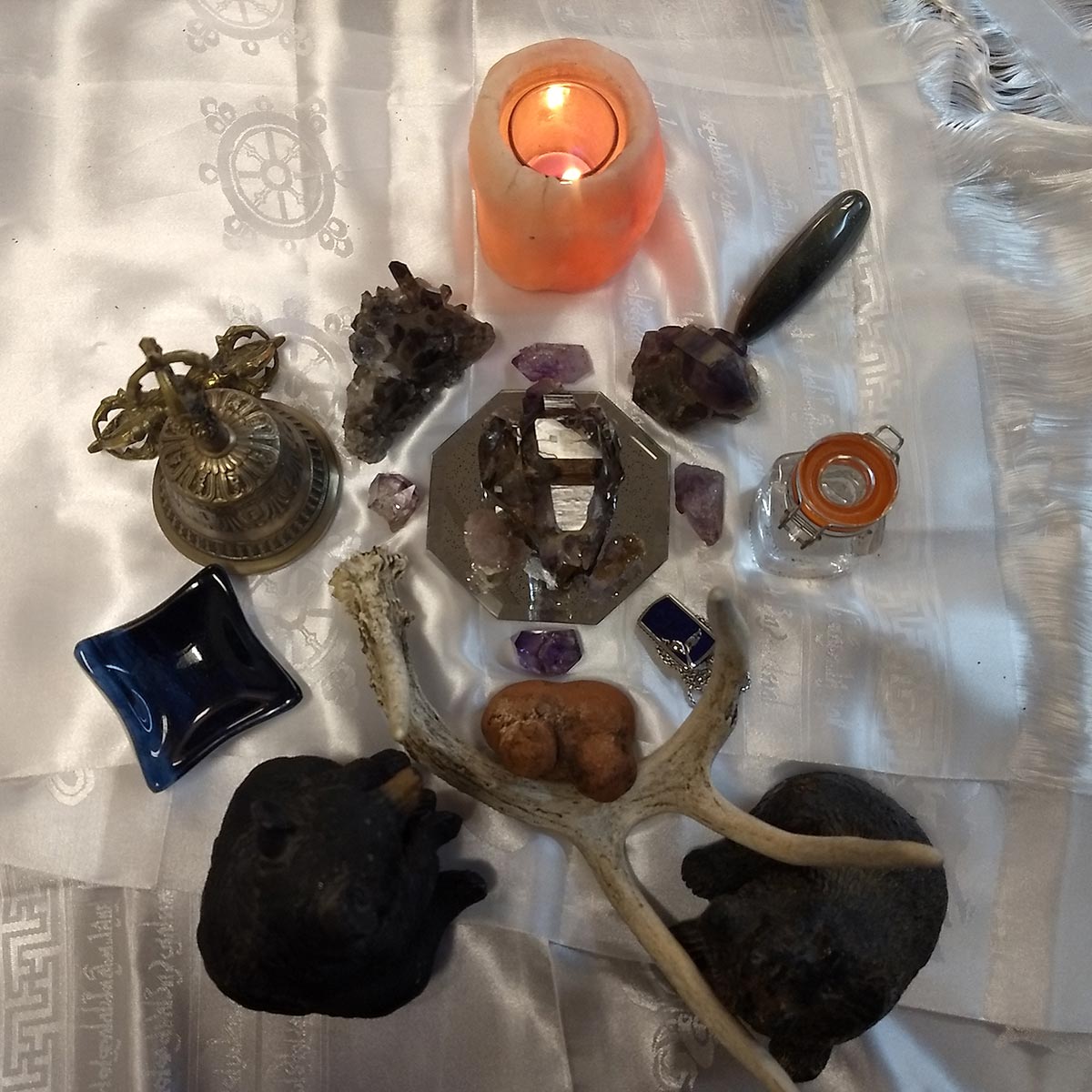One of the primary functions of a spiritual altar is to serve as a focal point for prayer, meditation, and spiritual practices. It’s a place that helps ground your spiritual energy and aids in concentrating your spiritual intentions. When you dedicate time and attention to your altar, you’re strengthening your connection with the divine and aligning yourself with cosmic energy.
Contents
What is a spiritual altar?
In the realm of spirituality, an altar is more than just a physical structure. It is a sacred space, a portal if you will, to the divine realms. It is a place where you can connect with the spiritual entities you believe in, whether that be God, the Universe, ancestors, or spirit guides. A spiritual altar can be viewed as a bridge between the earthly and spiritual dimensions, a conduit of divine energy.
In a broader perspective, a spiritual altar can also serve as a spiritual tool to manifest your intentions and desires. By placing symbolic objects, crystals, or images that represent your goals and dreams, you’re essentially sending a clear message to the universe about what you want to manifest in your life. This process is often referred to as ‘altar work’ or ‘working the altar’ in many spiritual traditions.
Building and maintaining a spiritual altar can be a deeply enriching practice. It encourages mindfulness, nurtures a sense of the sacred, and can bring a profound change in your life. The physical act of setting up an altar, choosing the elements, and arranging them consciously, can be a form of meditation in itself.
Psychological Perspective
From a psychological perspective, having a spiritual altar can serve as a reminder of your spiritual commitments. It’s a visual and tangible representation of your spiritual journey. Every time you see or interact with your altar, you’re reminded of why you started this spiritual journey and the intentions you’ve set for yourself.
It’s important to note that an altar is deeply personal, and there are no hard and fast rules for creating one. The most important aspect is that it should be meaningful and resonant with you. Some people might prefer elaborate altars with many items, while others may opt for a minimalist approach. The size, components, and location of your altar can vary greatly depending on your personal preferences and spiritual traditions.
Why Build a Spiritual Altar?
Having a spiritual altar in your home (or even a dedicated space within a room) is not about religious duty, ritualistic obligation, or aesthetic appeal. It’s about something much more profound: creating a tangible, physical space for your inner spiritual journey. An altar serves as a bridge between the physical and spiritual realms, a point of connection to the unseen world where our deepest thoughts, intuitions, and emotions reside. It’s not just a table with pretty objects, but a living, breathing, evolving reflection of your spiritual journey.
But why should we bother building one? Isn’t it enough that we hold our spiritual beliefs in our hearts? Here are three primary reasons:
- Bridging the inner and outer worlds: In our fast-paced, busy lives, the line between our external circumstances and our inner spiritual life can often become blurred. An altar can help maintain that connection, acting as a physical reminder of our spiritual journey.
- Sacred space: An altar provides a specific, dedicated space for prayer, meditation, or other forms of spiritual practice. This can help anchor your practice, making it a regular part of your daily life.
- Manifestation of intent: The act of creating an altar is in itself a powerful spiritual practice. It’s an outward expression of an inward intent, turning abstract spiritual concepts into tangible, physical realities.
Your Spiritual Journey
A spiritual altar then, becomes a living embodiment of your spiritual journey. It grows with you, changes with you, and evolves as your understanding and experience of the spiritual realm deepens. This is why it’s such a powerful tool for personal growth and spiritual development.
However, it’s important to remember that an altar is merely a tool. It does not possess any inherent power of its own, but is instead a conduit for your own spiritual energy. As such, the most important element of any altar is not the objects it contains, but the intention with which it’s created.
The power of the altar lies not in the objects, but in the intention.
So, whether you’re a seasoned spiritual practitioner looking for a way to deepen your practice, or a newbie just starting out on your spiritual journey, consider building a spiritual altar. It’s a simple, yet powerful way to manifest your spiritual intentions in the physical world.
Different Kinds of Spiritual Altars
Altars can be as diverse as the spiritual practices they represent, each holding a distinct energy and purpose. They act as a focal point, holding the essence of your intentions and acting as a conduit between your physical existence and the spiritual realm. The myriad of altars include personal altars, ancestral altars, seasonal altars, and elemental altars, to name a few. However, the design and purpose of each altar vary widely, reflecting the unique spiritual journey of the individual.
Personal Altars
A personal altar is a sacred space dedicated to your spiritual growth and self-realization. It serves as a personal sanctuary, a place where you can retreat, reconnect, and re-center. This altar can include personal artifacts, symbols of your spiritual path, and items that hold special significance for you (like crystals, amulets, or photos of loved ones).
Ancestral Altars
An ancestral altar pays homage to your lineage, connecting you with your roots and offering respect and reverence to those who came before you. This kind of altar typically includes photographs of deceased relatives, heirlooms, and other familial artifacts. Through this connection, you honor your ancestors’ wisdom and guidance, drawing strength from their experiences and teachings.
Seasonal Altars
Seasonal altars align your energy with the cyclical patterns of nature, enabling you to tap into the potent energies of each season. An altar for spring might feature budding branches and fresh flowers, symbolizing growth and renewal, while a winter altar might include pine cones and holly, representing the quiet, introspective power of the season.
Elemental Altar
An elemental altar serves as a tangible representation of the fundamental forces of nature—earth, air, fire, and water. Each element holds unique energy and qualities, and by honoring these elements, you can manifest their qualities in your life. For instance, a water altar might help you cultivate emotional intelligence and flexibility, while an earth altar might ground you and connect you with nature’s rhythms.
In essence, the kind of altar you create depends on your intention and spiritual path. It’s essential to remember that your altar is an extension of you—it should embody your energy, values, and spiritual aspirations, making it a powerful tool in your spiritual journey.
What to Put on a Spiritual Altar?
When it comes to determining what to put on a spiritual altar, the guiding principle is that it should be a reflection of your personal spiritual journey. The items you choose to put on your altar should inspire, uplift, and resonate with you on a deep, spiritual level. They should serve as powerful reminders of your spiritual goals and aspirations, and help you focus your thoughts and energy on these. It’s not so much about the physical properties of the items themselves, but about the spiritual significance they hold for you.
Common Items to Include on a Spiritual Altar
Though the specifics of what you put on your altar will greatly vary depending on your personal spiritual beliefs and practices, there are some common items that many people choose to include. Here are a few:
- Sacred Texts or Inspirational Writings: These can be religious scriptures, spiritual teachings, personal affirmations, or any written material that holds spiritual significance for you.
- Icons, Statues, or Images: These can be images or representations of deities, spiritual leaders, or any symbol that holds a special spiritual meaning to you. They can help create a visual focus for your spiritual practice.
- Candles: Candles are often used to represent the element of fire and can be used to create a soothing, meditative atmosphere. Their light can symbolize enlightenment or the divine.
- Incense or Essential Oils: These are used to represent the element of air. The scent can help create a sacred space and set the mood for your spiritual practice.
- Crystals: Crystals are often used to represent the element of earth and can be used for their healing properties or as a focus for meditation.
- Water: A small bowl of water can represent the element of water, which is often associated with emotions and intuition.
Remember, the items you choose to put on your spiritual altar should be deeply personal and meaningful to you. It is a space for you to connect with your spiritual self, and as such, should reflect your own spiritual journey and aspirations.
Arranging Items on Your Spiritual Altar
The arrangement of items on your spiritual altar is as important as the items themselves. It is not simply a matter of aesthetics, but also of energy flow. The way you arrange your altar can have a significant impact on the energy of the space and, by extension, your spiritual practice.
Most people prefer to arrange their altars in a way that represents the cardinal directions (north, south, east, and west), with each direction corresponding to a specific element (earth, air, fire, and water, respectively). However, the arrangement should ultimately be guided by your own intuition and spiritual beliefs.
It’s also important to keep your altar clean and clutter-free, as a cluttered altar can lead to a cluttered mind. Make it a habit to regularly clean your altar and rearrange the items as needed to maintain a clear and positive energy flow.
The spiritual altar is a sacred space that is deeply personal and unique to each individual. There’s no right or wrong way to create one. Trust your intuition, follow your spiritual instincts, and create an altar that reflects your personal spiritual journey.
How to Create a Sacred Space Around Your Spiritual Altar
In our chaotic and fast-paced world, creating a sacred space around your spiritual altar can serve as a sanctuary, a place of calm and serenity where you can connect with your spiritual self and engage in deep, personal introspection. It’s essential to understand that a sacred space is not just a physical location, but a spiritual and mental oasis that allows you to align your energy with your intentions, enhancing your spiritual practice.
Steps to create a sacred space around your spiritual altar
- Choose a Location: Start by identifying a location that resonates with you—a place where you feel calm, relaxed, and at peace. It could be a corner of your room, a space in your garden, or even a designated area in your living room. Remember, this should be a place you can easily access but also offers some degree of privacy for your spiritual practice.
- Cleanse the Area: Once you’ve chosen a location, it’s crucial to cleanse the area to dispel any stagnant or negative energy. This can be accomplished by burning herbs such as sage or palo santo, or using a saltwater solution to purify the space. Please remember to use caution and respect in this process, recognizing that these practices are sacred to many cultures.
- Define Your Space: Establish boundaries for your sacred space. This could be a physical delineation, such as a rug or mat, or a symbolic one, like an arrangement of stones or crystals. This helps to create a special atmosphere and signals to your subconscious mind that this is a place of spiritual significance.
- Decorate Your Space: Decorate your space in a way that reflects your personal beliefs and spiritual journey. This could include religious or spiritual symbols, images of deities or spiritual masters, inspirational quotes, or even personal items that hold deep meaning for you.
- Consistency is Key: Consistency in using your sacred space is crucial. Make an effort to spend time here each day, whether for meditation, prayer, or simply quiet reflection. This regular practice will imbue the area with your energy, making it truly your sacred space.
Not Just Physical
Creating a sacred space around your spiritual altar is not only about physically arranging items. It’s about establishing a profound connection between the physical realm and your inner spiritual world, fostering a sense of peace, healing, and spiritual growth. With time, your sacred space can become a powerful spiritual tool, amplifying your intentions and facilitating a deeper connection with the divine.
Rituals and Practices to Enhance the Power of Your Spiritual Altar
As we delve deeper into the spiritual labyrinth, it becomes evident that a spiritual altar’s power is not inherent but cultivated. The potency of your altar depends largely on your actions—how you engage with it, the rituals you perform, and the respect you accord it. Therefore, to enhance the power of your spiritual altar, certain practices and rituals are essential.
Firstly, let’s discuss why these practices are important. The spiritual altar is a bridge, connecting us to the divine, the universe, and our deepest self. It is a physical manifestation of our spiritual journey. But like any relationship, it needs care, attention, and respect to flourish. The rituals we perform at our altar are the ways we communicate our intentions and desires to the universe (or whichever higher power we believe in). They are the signals we send out into the cosmos, hoping for alignment, peace, and fulfillment in return.
Power Enhancing Practices
- Regular Cleansing: The energy around us and our altars can become stagnant over time. Regular cleansing (using sage, incense, or simply dusting and cleaning) can help keep the energy fresh and vibrant.
- Offerings: Offerings are a way of expressing gratitude to the divine. They can be anything from flowers, incense, to food, or even a simple heartfelt prayer.
- Meditation: Sitting in front of your altar and meditating regularly can help you connect more deeply with your intentions and the divine. Try to make it a daily practice.
- Prayer: Prayers are a powerful way to communicate your desires and intentions. You can use traditional prayers or simply speak from your heart.
It’s important to note that these practices are not rigid rules, but guidelines. Feel free to adapt them to your beliefs and comfort level. Remember, the altar is your personal spiritual space, and it should reflect and respect your unique spiritual journey.
The spiritual altar is a sacred space, a bridge between the human and the divine. The power you cultivate from your practices and rituals here can profoundly impact your spiritual growth.
Arrangement of Objects
Beyond these practices, it’s also beneficial to consider the arrangement and objects placed on your altar. The power of your altar can be magnified by choosing objects that resonate with your intentions and arranging them in a way that enhances their energy. This can involve using crystals, symbols, images, and other sacred items that align with your spiritual path. The act of arranging these objects can also become a ritual in itself, deepening your connection with your altar and your spiritual beliefs.
Lastly, remember that consistency is key. The more consistently you engage with your altar, the stronger the connection will become. It’s not about the grandeur of your rituals, but the sincerity and regularity of your practice. So engage with your altar regularly, respect it as a sacred space, and watch as it becomes a powerful tool in your spiritual journey.
How to Maintain and Care For Your Spiritual Altar
As a crucial part of your spiritual practice, your spiritual altar requires regular care and maintenance to retain its potency. This is not merely a decorative element; it’s an energetic hub, a focal point of your spiritual life. Allowing it to gather dust or become cluttered can diminish its effectiveness and even create negative energy in your environment. Therefore, maintaining your altar is essential.
Regular Cleaning
Just like any other area of your home, your altar needs to be kept clean. Dust, clean, or polish the altar surface and the items on it regularly. Be mindful not to use harsh cleaning products as these can disrupt the spiritual energy of your altar. Instead, opt for natural, gentle cleaning agents. Also, remember to handle each item with care and respect as you clean, acknowledging the spiritual significance of the artifacts.
Refreshing Offerings
If you have offerings on your altar, such as fresh flowers, water, or food items, ensure they are fresh. Withered flowers, stale food, and stagnant water can create negative energy. Replace these items regularly, ideally every day. As you do this, hold the intention of your offering in your heart, reinforcing the spiritual exchange between you and the divine.
Recharging Items
The items on your altar – crystals, icons, statues, etc. – can absorb energy from their environment, both positive and negative. To ensure they remain potent and beneficial, they should be recharged regularly. This can be done in several ways, such as bathing them in moonlight, sunlight, burying them in the earth, or smudging them with sage or other cleansing smoke.
Periodic Reorganization
Over time, as your spiritual journey evolves, so too might the significance of certain items on your altar. It’s important to reflect this evolution on your altar. This could involve removing items that no longer resonate with you, adding new ones, or rearranging the layout. Always remember that your altar is a reflection of your personal spiritual journey, and it should evolve as you do.
Respecting Your Altar
Last but not least, always approach your altar with respect. This is a sacred space, and treating it as such helps maintain its energy and power. Avoid using it as a storage space for non-spiritual items, and when you approach it for prayer, meditation, or ritual, do so with a clear, focused mind and a respectful attitude.
As you can see, maintaining a spiritual altar is an ongoing process, closely tied to your own spiritual journey. By investing time and attention in your altar, you create a powerful, sacred space that supports and enhances your spiritual practice.
In Conclusion
If you’re interested in learning more, consider reading my book Living a Sacred Life: The Path to the Superconscious through Meditation and Spirit Contact.












